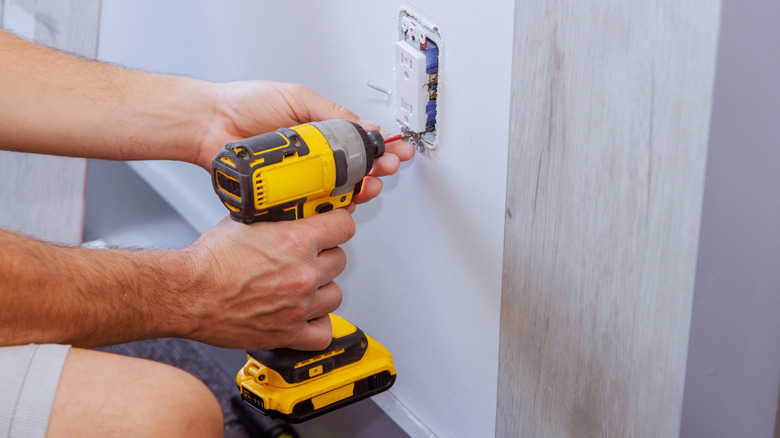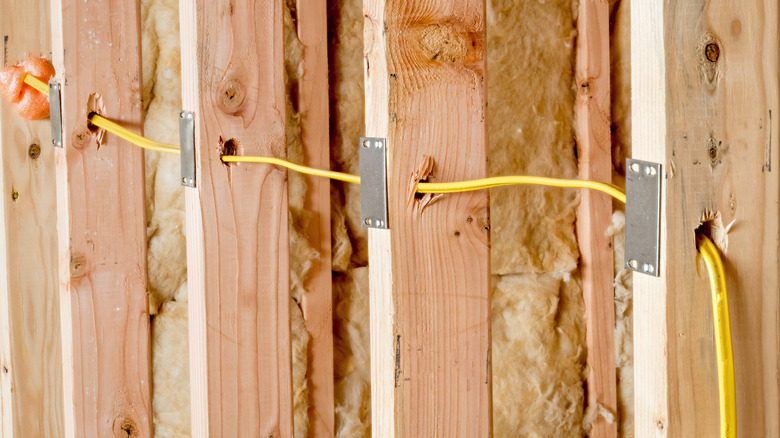Install An Electric Outlet To A Finished Wall Without Drywall Damage`
Homeowners probably know that you can often add or replace electrical outlets yourself, but many still shy away from adding outlets to a room when they need them. The reason often has little to do with electrical code compliance or even with the risk of fire or electrocution. It's something that's far more primal for some: The fear of drywall. Luckily, YouTuber Everyday Home Repairs has a genius way to add an outlet to a wall that only requires you to cut into drywall that will never be seen.
Everyday Home Repairs' method only requires that you have access to a working outlet on the same wall to run behind your baseboard and serve as the source of your new outlet's power. Beyond that, his brilliantly simple solution is simply to remove your baseboard, then carefully remove drywall to its height, minus about a ¼-inch. This ensures that after you replace the baseboard, it will cover any damage to the drywall.
There are a few complexities that you'll have to deal with, one being that baseboards have been experiencing a long-term decline in popularity. So while the most common baseboard heights are 3 ¼, 5 ¼, and 4 ¼ inches, you might find that a more modern home has baseboards as small as 2-3 inches, which might make this receptacle trick prohibitively difficult. Other modern homes might make use of a "gallery base" or "museum base" (which has a small reveal recessed at the bottom of the drywall) or might not include a baseboard or a reveal. In those cases, you're probably stuck with breaking into visible drywall, unless you want to add a baseboard to that particular wall to cover your work.
Stud-drilling that won't keep your inspector up at night
The other complexities of adding an outlet by running wire behind a baseboard are generally the same as for any other receptacle-wiring job. But one thing to note is the narrowness of the space you have to work with, which can make ordinary tasks unusually difficult. For example, since you'll almost certainly be running nonmetallic (NM) cable (often referred to by the brand name Romex) through wall studs, you'll need to drill holes in the studs to support the cord and allow it to pass through. Normally this is fairly trivial. Electrical code requires 1 ¼ inches on each side of holes bored for NM cable. But in a 2-by-4-inch stud wall, that only leaves 1 inch as your maximum hole size.
Since you're working within a small opening, you might also be forced to drill at an angle, which reduces your margin for error on hole location and size. Drilling straight on, you could go up to a 1-inch hole, but at an angle, you can create a hole of ¾-inch diameter (which is the standard anyway) for supporting a single run of NM cable. (If, for some reason, you expect to run two cables, drill a ⅞-inch hole.) Use a spade or auger bit for the hole, and use a drill extension if you don't have tall enough baseboards to get a drill or impact driver into the stud bays.
Other aspects of safely supporting your Romex cable
There are a couple of other typical code requirements you should be aware of when using this baseboard trick. One is that if, for some reason, you can't achieve the 1 ¼-inch clearance between the edge of your studs, you are usually required to use a steel bushing in each hole or a steel plate on the edge of each stud. This prevents accidental penetration of the cable with nails or screws in the future. The steel plates can be difficult or impossible to fit behind a typical baseboard, forcing you to use bushings, which you might struggle to insert into holes bored at an angle. It's best to center your holes as well as possible so you don't have to contend with this issue.
Also note that you're usually required by code to staple NM cable within 12 inches of an electrical box, and your new receptacle is no exception. The bottom of outlet boxes is usually set about 12 inches from the top of your finished flooring, though you might occasionally find that some outlets installed higher up on walls, especially in older homes. So stapling the NM cable within 12 inches of the box should be doable as long as you bore your studs low enough to allow room for attaching the cord just above the hole. Fortunately, you only have to do this once per new outlet. When your work is done, don't forget to test your outlet for power and safety before closing up the wall. The baseboard outlet hack is easy, but that's no reason to do it twice.

